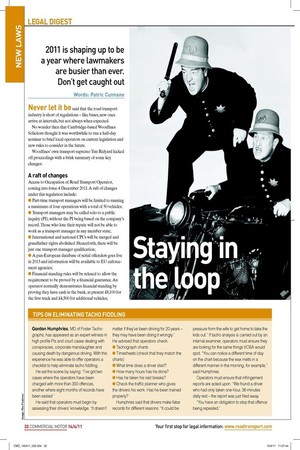TIPS ON ELIMINATING TACHO FIDDLING
Page 21

If you've noticed an error in this article please click here to report it so we can fix it.
Gordon Humphries, MD of Foster Tachographs, has appeared as an expert witness in high profile PIs and court cases dealing with conspiracies, corporate manslaughter and causing death by dangerous driving. With this experience he was able to offer operators a checklist to help eliminate tacho fiddling.
He set the scene by saying: “I’ve got two cases where the operators have been charged with more than 300 offences, another where eight months of records have been seized.” He said that operators must begin by assessing their drivers’ knowledge. “It doesn’t matter if they’ve been driving for 20 years – they may have been doing it wrongly.” He advised that operators check: ● Tachograph charts ● Timesheets (check that they match the charts) ● What time does a driver start?
● How many hours has he done?
● Has he taken his rest breaks?
● Check the traffic planner who gives the drivers his work. Has he been trained properly?
Humphries said that drivers make false records for different reasons: “It could be pressure from the wife to get home to take the kids out.” If tacho analysis is carried out by an internal examiner, operators must ensure they are looking for the same things VOSA would spot. “You can notice a different time of day on the chart because the wax melts in a different manner in the morning, for example,” said Humphries.
Operators must ensure that infringement reports are acted upon. “We found a driver who had only taken one-hour, 36-minutes daily rest – the report was just filed away.
“You have an obligation to stop that offence being repeated.”









































